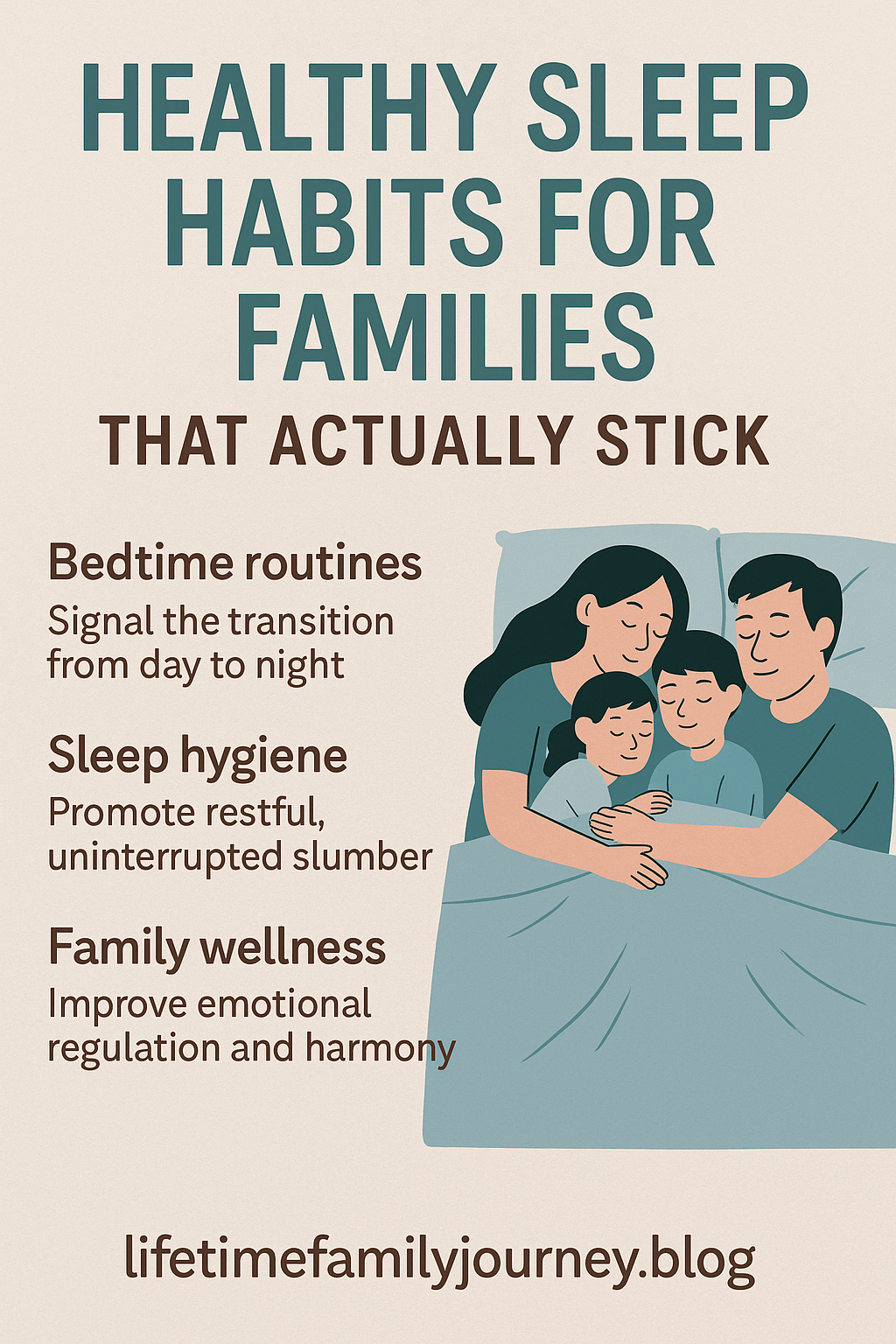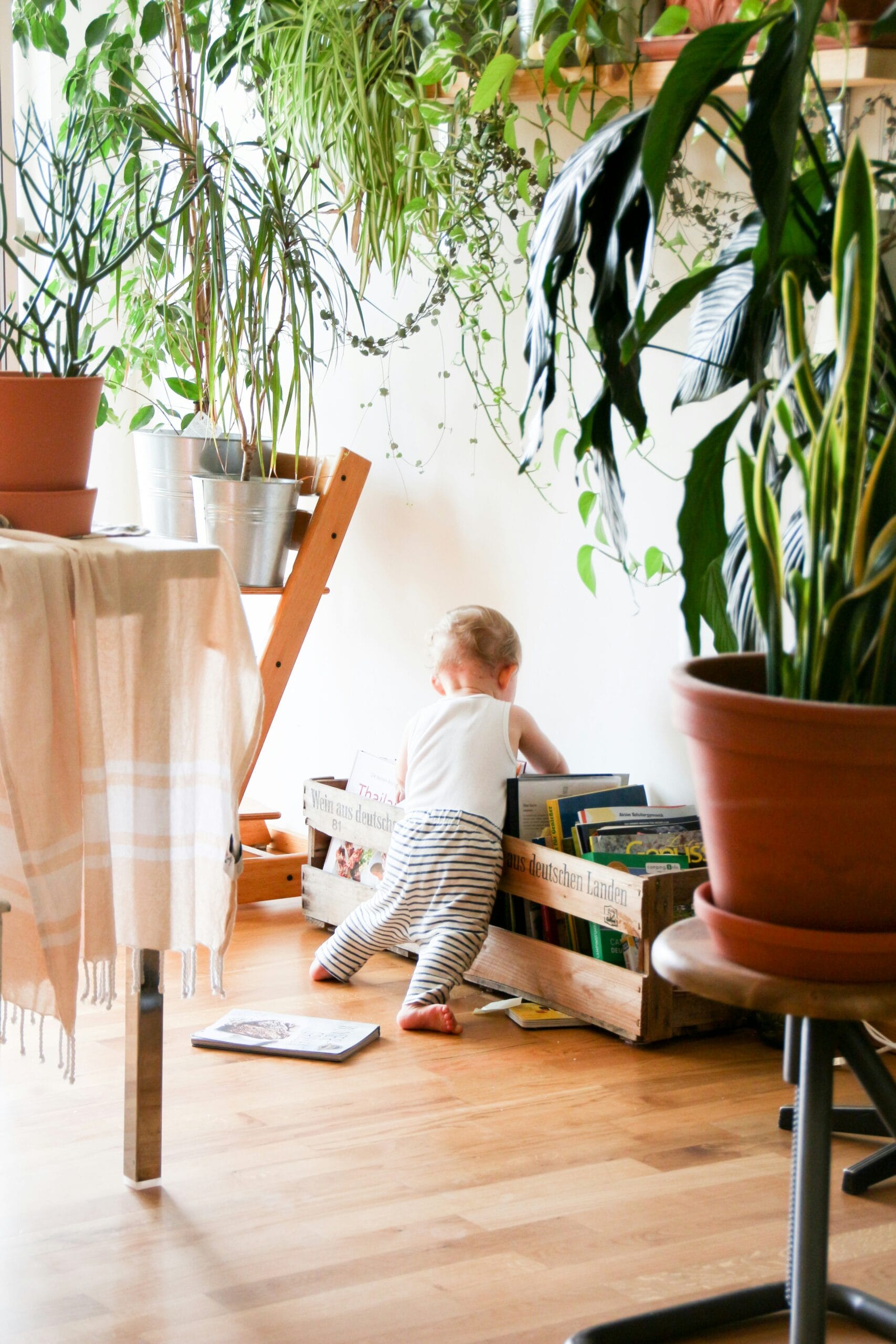Healthy Sleep Habits for Families That Actually Stick

Ever watch a nature documentary where the narrator calmly explains how lions sleep 20 hours a day while you’re sitting there with bags under your eyes, wondering when your own cubs last slept through the night? 😴
Six kids later, I’ve learned that sleep in a busy household is like trying to herd cats while blindfolded—theoretically possible, but requiring skills they definitely don’t teach in parenting classes.
There’s Brayden (6) who thinks bedtime is merely a suggestion, Melody (15) who’s convinced her natural bedtime is somewhere around midnight, and the rest of our crew scattered across the age spectrum, each with their own unique approach to avoiding sleep. Some nights our house sounds like a zoo where all the animals have decided to hold a conference at 2 AM.
But here’s what I’ve discovered through years of trial, error, and more coffee than any human should reasonably consume: healthy sleep habits for families aren’t just possible—they’re absolutely achievable without requiring a PhD in child psychology or the patience of Mother Teresa.
When families prioritize sleep, everything else gets easier. Kids have better emotional regulation. Parents have more patience for the inevitable spills and sibling conflicts. Even family game night becomes less likely to end in tears (theirs and yours).
Ready to transform your household from sleep-deprived chaos to well-rested harmony? Let’s dive into strategies that actually work in the real world of busy families.
The Science Behind Family Sleep (And Why It Matters More Than You Think) 🧠
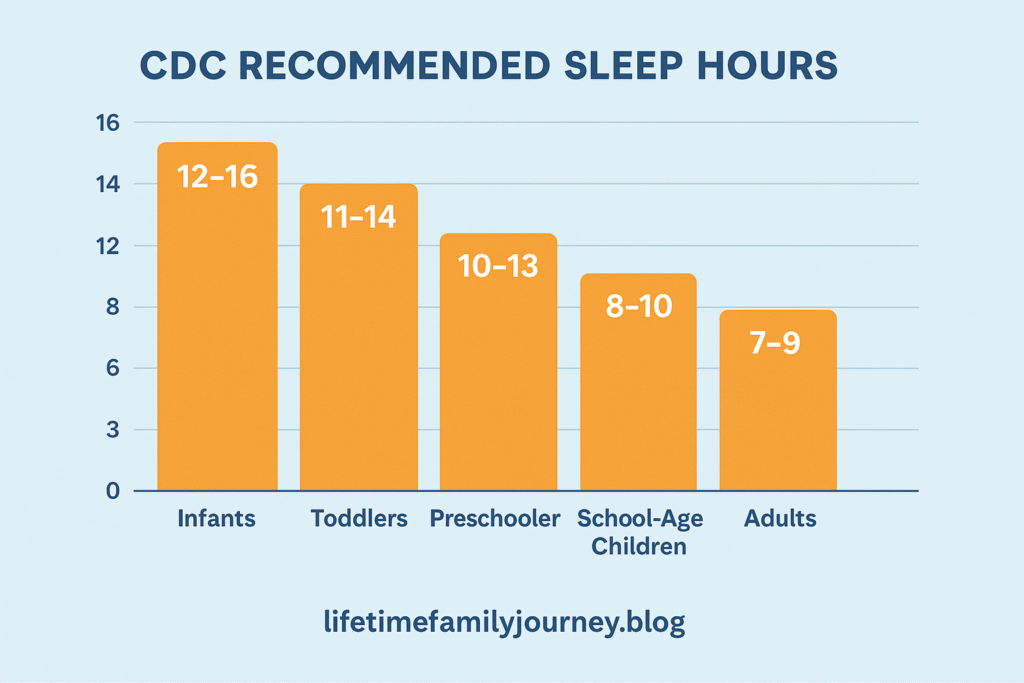
Have you ever noticed how your sweetest child can transform into a tiny tyrant when they’re overtired? There’s actual science behind this Jekyll-and-Hyde transformation that makes perfect sense once you understand what’s happening in those little brains.
During sleep, children’s developing minds are incredibly busy. They’re consolidating memories from the day, processing emotions, and literally building the neural pathways that will serve them throughout their lives. Think of sleep as the brain’s nightly maintenance crew—filing away important information, clearing out mental clutter, and preparing for tomorrow’s adventures.
When kids get consistent, quality sleep, they’re better equipped to focus in school, regulate their emotions, and make good decisions. When they don’t? Well, you’ve probably witnessed the epic meltdown that happens when an overtired four-year-old is asked to put on shoes. It’s like watching a computer crash in real-time.
For parents, sleep serves as our daily reset button. It’s when our bodies recover from the physical demands of chasing toddlers, lifting car seats, and somehow always finding ourselves crawling around on playground equipment designed for people half our size. More importantly, it’s when our stress hormones regulate and our emotional resilience recharges.
Understanding circadian rhythms—our internal body clocks—helps explain why timing matters so much when establishing quality rest routines. These biological timepieces are influenced by light exposure, meal times, and daily routines. When we work with these natural rhythms instead of against them, sleep comes more naturally for everyone.
The CDC’s sleep guidelines provide clear recommendations: toddlers need 11-14 hours, school-age children need 9-11 hours, teens need 8-10 hours, and adults need 7-9 hours. But knowing the numbers and achieving them in real family life are two very different challenges.
📊 Sleep Requirements by Age:
• Toddlers (1-2 years) → 11-14 hours per day
• Preschoolers (3-5 years) → 10-13 hours per day
• School-age (6-13 years) → 9-11 hours per day
• Teenagers (14-17 years) → 8-10 hours per day
• Adults (18+ years) → 7-9 hours per day
↗️ Reality check: Most families fall short of these recommendations!
The ripple effects of poor sleep extend far beyond cranky mornings. Sleep-deprived children are more likely to struggle academically, have behavioral problems, and experience difficulties with peer relationships. Exhausted parents make more mistakes, have less patience, and often find themselves caught in cycles of family conflict that good rest could prevent.
⚠️ The Sleep Deprivation Domino Effect:
• For Kids:
- ➤ Academic struggles & poor concentration
- ➤ Emotional meltdowns & behavioral issues
- ➤ Weakened immune system (more sick days!)
- ➤ Difficulty with peer relationships
• For Parents:
- ➤ Increased irritability & impatience
- ➤ Poor decision-making abilities
- ➤ Higher stress hormone levels
- ➤ More family conflicts and arguments
↗️ The good news: All of these reverse when sleep improves!
What’s your family’s biggest sleep challenge? Is it getting everyone to bed on time, or does the real battle happen at 5 AM when nobody wants to wake up? Understanding these patterns is the first step toward creating healthy sleep habits for families that actually stick.
Bedtime Routines for Healthy Sleep Habits for Families (Without Starting World War III) ⭐
Creating effective bedtime routines requires the strategic planning of a military operation combined with the flexibility of a yoga instructor. The goal is simple: signal to your children’s bodies and minds that it’s time to transition from the excitement of day to the calm of night.
Sounds easy, right? Tell that to the five-year-old who suddenly discovers an urgent need to reorganize their sock drawer the moment you mention bedtime.
The magic happens in consistency—doing the same calming activities in the same order every single night. This predictable sequence helps children’s nervous systems shift into sleep mode naturally. Bath time becomes more than just getting clean; it’s a warm, soothing activity that literally helps lower body temperature, which naturally promotes sleepiness.
Here’s what works in our house: we start winding down about an hour before actual bedtime. Lights get dimmed throughout the house (this signals everyone’s circadian rhythms), screens go away completely, and we begin the routine. Bath or face washing, brushing teeth (despite Brayden’s protests that toothbrushes are medieval torture devices), putting on pajamas, and then story time.
Our Evening Wind-Down Formula:
• One hour before bed → Dim all lights throughout the house
• 45 minutes before → All screens off (yes, even for parents!)
• 30 minutes before → Start the physical routine (bath, teeth, pajamas)
• 15 minutes before → Story time and quiet connection
• Bedtime → Lights out with hugs and “see you in the morning”

Story time isn’t just entertainment—it’s a quiet bonding activity that engages imagination while calming the nervous system. Even teenagers can benefit from this connection time, though their version might be sharing highlights from their day or discussing tomorrow’s plans rather than reading picture books.
The enemies of good bedtime routines are overstimulation and inconsistency. Screens are particularly problematic because blue light interferes with melatonin production, but beyond the science, they tend to amp up excitement when we want calm. The same goes for sugary snacks (energy bursts when we want winding down) and impromptu wrestling matches in the living room (trust me, this backfires every time).
🚫 Bedtime Routine Saboteurs (Avoid These!):
• Screen time within 1 hour of bed → Blue light suppresses melatonin
• Sugary snacks after dinner → Energy spikes when you want calm
• High-energy activities → Wrestling, tickle fights, loud music
• Inconsistent timing → Different bedtimes confuse circadian rhythms
• Overstimulating conversations → Save serious talks for daytime
• Caffeinated drinks → Even chocolate can be problematic for sensitive kids
✅ Bedtime Routine Champions (Do More of These!):
• Dim lighting → Signals brain to produce sleepy hormones
• Warm baths → Natural body temperature drop promotes sleep
• Quiet activities → Reading, gentle stretching, soft music
• Consistent timing → Same routine, same time every night
• Comfort rituals → Special blankets, stuffed animals, brief prayers
• Connection time → Calm conversations about the day
↗️ Pro tip: Replace one “saboteur” with one “champion” each week for gradual improvement!
For busy parents feeling overwhelmed by the idea of elaborate routines, here’s the good news: effective bedtime routines don’t need to be complicated. A simple sequence of washing up, brushing teeth, reading one story, and a few minutes of quiet conversation can work wonders. The key is consistency, not complexity.
The “Bare Minimum” Bedtime Routine That Still Works:
• Wash face and hands (or quick bath if needed)
• Brush teeth (expect negotiations here)
• Put on pajamas • Read ONE story (stick to this limit!)
• Two minutes of quiet chat about tomorrow
• Lights out with hugs
↗️ Pro tip: Even this simple routine works miracles when done the same way every night!
What bedtime battles does your family face? Do you have a child who suddenly becomes incredibly thirsty, needs seventeen hugs, or remembers urgent homework the moment their head hits the pillow? These stalling tactics are completely normal—and usually mean your routine needs fine-tuning rather than abandoning.
Remember that your own energy directly impacts your children’s ability to settle down. When you’re stressed, rushing, or feeling frazzled during bedtime routines, kids pick up on that energy and mirror it back. This is why maintaining your own wellness—something we explore in depth in Building Strong Family Traditions That Last—isn’t selfish but essential for creating peaceful evenings and supporting healthy sleep habits for families.
Signs Your Bedtime Energy Needs an Adjustment:
• You find yourself snapping at kids during the routine
• Everyone seems more wound up, not less
• Bedtime feels like a battle instead of a wind-down
• You’re constantly watching the clock instead of being present
↗️ Quick fix: Take three deep breaths before starting bedtime. It sounds simple, but it works!
Teen Sleep Challenges (AKA Living with Vampires) 🦇
If you have teenagers, you’ve probably noticed they’ve transformed into nocturnal creatures who think 10 PM is an appropriate time to start homework and midnight is when their social lives really begin. Before you assume this is pure rebellion designed to test your sanity, there’s fascinating science behind their vampire-like behavior.
During adolescence, teenagers experience a natural shift in their circadian rhythms called delayed sleep phase. Their bodies literally start producing melatonin later in the evening, making it genuinely difficult for them to fall asleep before 11 PM or midnight, regardless of how early they went to bed as children.
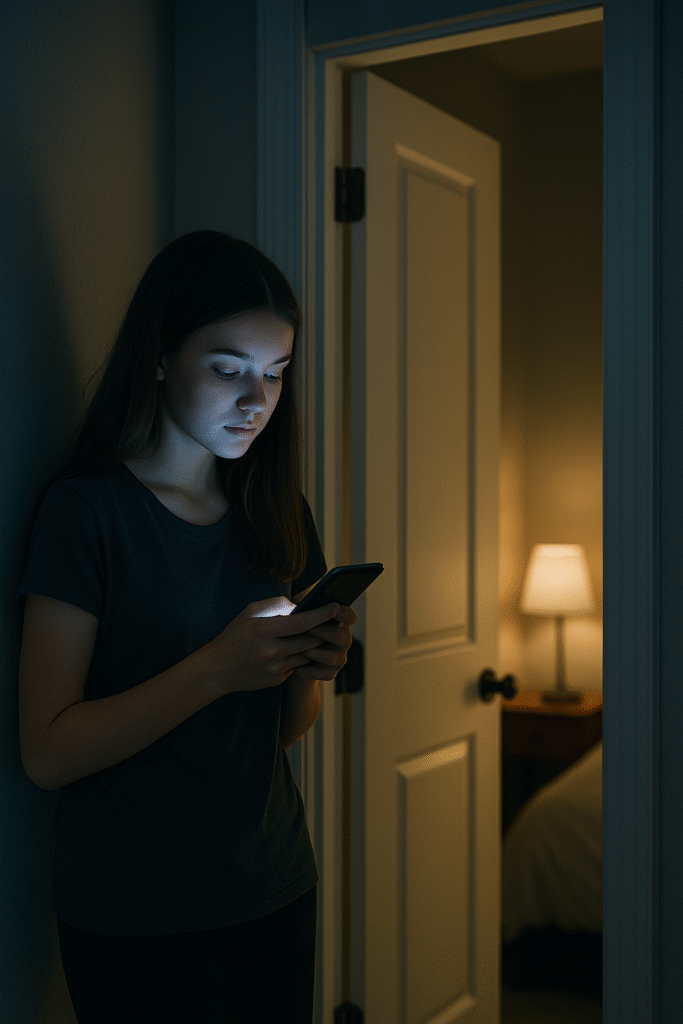
My teens treat bedtime suggestions like personal attacks on their human rights, complete with dramatic sighs and detailed arguments about why they’re “not tired yet” at 11:30 PM. But understanding this biological reality has helped me approach teen sleep challenges with more empathy and better strategies.
The key with teenagers is negotiating realistic bedtimes that acknowledge their natural sleep patterns while ensuring they get adequate rest. This might mean accepting that your teen genuinely can’t fall asleep at 9 PM like their younger siblings, but they can commit to being in their room with lights dimmed by 10:30 PM, working on quiet activities that promote relaxation.
Teenage Sleep Negotiation Tactics That Actually Work:
• Acknowledge the science → “I know your body doesn’t get sleepy until later now”
• Set room time, not sleep time → “Lights dimmed and in your room by 10:30”
• Offer wind-down options → Reading, journaling, gentle stretching, quiet music
• Maintain wake times → Consistent morning schedules help regulate everything else
• Weekend flexibility → Allow some later bedtimes but not drastically different wake times
Phone and screen usage becomes particularly challenging because devices serve as teenagers’ primary social connection with peers. Complete phone bans feel harsh and unrealistic, but unlimited screen time right up to sleep is equally problematic. Consider establishing phone-free zones and times rather than all-or-nothing rules.
📱 Teen Screen Time Solutions (That Actually Work):
• The Charging Station Method:
- ➤ All devices charge in kitchen/living room overnight
- ➤ No phones in bedrooms after 10 PM
- ➤ Morning access after getting ready for school
• The Wind-Down Window:
- ➤ Screens off 1 hour before target sleep time
- ➤ Use blue light filters after 8 PM
- ➤ Replace scrolling with books, journaling, or music
• The Weekend Compromise:
- ➤ Slightly later screen cutoffs on Friday/Saturday
- ➤ Same wake times to maintain rhythm
- ➤ Sunday returns to school-night rules
↗️ Remember: Teenagers’ brains don’t fully develop impulse control until age 25—they need our help with boundaries!
The Sleep Foundation’s research on adolescent sleep emphasizes that teenagers need 8-10 hours for optimal health, brain development, and emotional regulation. When teens don’t get enough sleep, they’re more likely to struggle with depression, anxiety, poor academic performance, and risky behavior—which affects the whole household.
Working with teenage sleep patterns instead of against them might mean allowing later weekend bedtimes while maintaining consistent wake times, or helping them create evening routines that honor their natural energy levels while still promoting eventual sleepiness.
One strategy that’s transformed our household is involving teenagers in creating their own sleep plans. When they feel ownership over their routines and understand the connection between sleep and their goals—better athletic performance, clearer skin, improved mood, higher grades—they’re more likely to make supportive choices.
How does your teenager approach bedtime? Do they claim they’re “different” and don’t need as much sleep, or have you found ways to work with their natural rhythms? The goal isn’t forcing a fifteen-year-old to sleep like a seven-year-old, but helping them develop healthy sleep habits for families that will serve them into adulthood.
Parent Sleep Hygiene (Yes, You Matter Too!) 💤
Here’s a reality check that might sting: you can’t pour from an empty cup, and you can’t model healthy sleep habits for families while running on fumes and caffeine prayers.
Yet somehow, in the chaos of family life, parents often treat their own sleep as a luxury rather than a necessity. We’ll stay up until midnight folding laundry, then lie in bed scrolling social media until 1 AM, then wonder why we feel like extras from a zombie movie when the kids wake us at 6 AM demanding breakfast and help finding their favorite socks.
The Parent Sleep Sabotage Hall of Fame:
• The Midnight Laundry Marathon → “I’ll just fold one more load…”
• The Social Media Scroll Trap → “Just five more minutes of mindless scrolling…”
• The Mental To-Do List Olympics → Racing thoughts the moment your head hits the pillow
• The Netflix “One More Episode” Syndrome → Because cliffhangers are evil
• The “Finally Me-Time” Phenomenon → Staying up late because it’s the only quiet time
↗️ Sound familiar? You’re not alone—and there are solutions!
Parents need healthy sleep habits for families too—maybe more than kids, because we’re the ones making countless daily decisions that affect everyone else. When we’re well-rested, we have patience for the fourth spilled juice cup and creativity to solve the crisis of the missing homework folder. When we’re exhausted, every small challenge feels monumental.
The first rule of parent sleep hygiene: phones don’t belong in beds. I know those precious few minutes of mindless scrolling feel like the only “me time” in a day filled with meeting everyone else’s needs. But screens in bed are sleep killers, interfering with melatonin production and activating your brain when it should be winding down.
Instead, try creating your own wind-down ritual. This might be reading actual books, gentle stretching, gratitude journaling, or quiet reflection. Sometimes my “bedtime routine” involves collapsing face-first into pillows after folding laundry at midnight, but when I’m intentional about creating calming pre-sleep activities, I fall asleep faster and sleep more soundly.
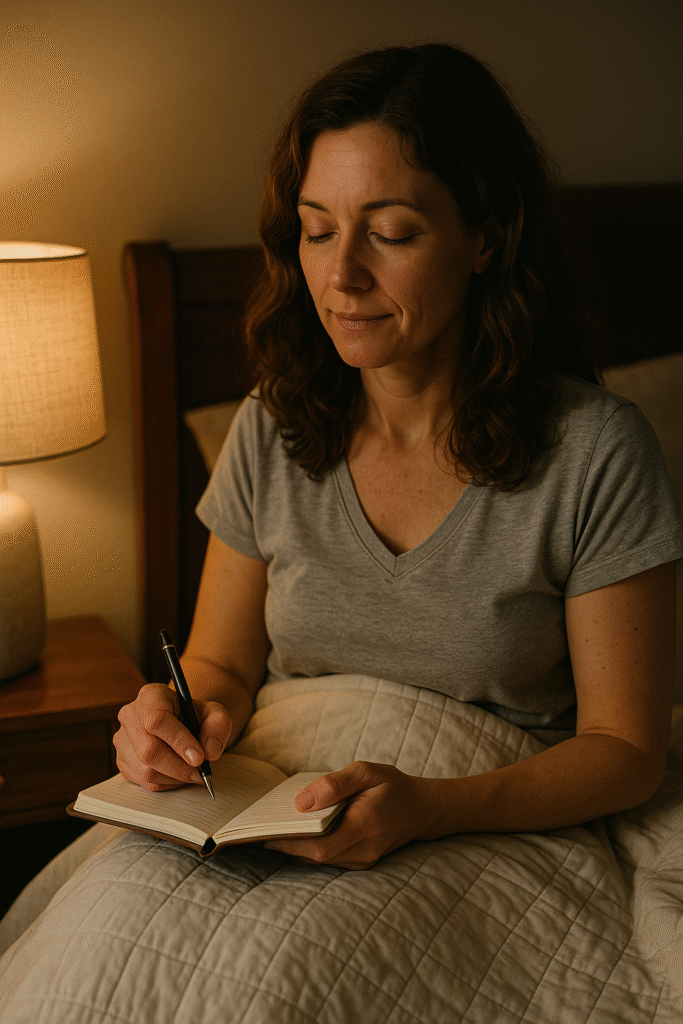
Parent-Friendly Wind-Down Activities:
• Read actual books (not backlit screens)
• Gentle stretching or basic yoga poses
• Gratitude journaling (even just three things you’re thankful for)
• Herbal tea and quiet reflection
• Deep breathing exercises (4 counts in, 6 counts out)
• Organizing tomorrow’s priorities (get it out of your head and onto paper)
Temperature matters more than you might realize. Our bodies naturally cool down as part of the sleep process, so bedrooms that are too warm interfere with this rhythm. Most sleep experts recommend 65-68 degrees Fahrenheit. I learned this the hard way after months of restless nights in our stuffy master bedroom—sometimes solutions are as simple as adjusting the thermostat.
🌡️ Temperature Impact Chart:
TOO HOT (72°F+) | JUST RIGHT (65-68°F) | TOO COLD (62°F-)
• Restless sleep | • Deep, restful sleep | • Frequent waking
• Night sweats | • Natural temp drop | • Muscle tension
• Frequent waking | • Easy sleep onset | • Difficulty falling asleep
• Morning grogginess| • Refreshed mornings | • Cold-related discomfort
🛏️ Quick Temperature Fixes:
• For hot sleepers: Cooling mattress pads, breathable pajamas, ceiling fans
• For cold sleepers: Layered blankets, warm (not hot) baths, fuzzy socks
• For mixed households: Separate blankets, adjustable bed zones, compromise at 67°F
↗️ Family hack: Let each person control their own blanket layers while keeping the room consistently cool!
Consistency helps adults just as much as children. Try going to bed and waking up at roughly the same times, even on weekends. This regulates your circadian rhythm and makes falling asleep and waking up feel more natural.
What’s your biggest obstacle to better sleep? Is it the mental to-do list that starts racing the moment your head hits the pillow, or the physical discomfort of trying to get comfortable after a long day of physical parenting demands?
Remember that prioritizing your sleep isn’t selfish—it’s essential for being the parent, partner, and person you want to be. For more on maintaining your well-being while caring for everyone else, check out our guide on Self-Care for Busy Parents: Finding Time for You, which includes strategies for developing healthy sleep habits for families.
Creating Sleep-Friendly Environments That Actually Work 🏠
Your physical sleep environment sends powerful messages to everyone’s brains about whether it’s time to be alert or time to rest. Creating spaces that promote good sleep isn’t about expensive renovations or Instagram-worthy bedrooms—it’s about simple changes that support natural sleep processes.
The Sleep Environment Checklist:
• Darkness is your friend → Room-darkening shades, cover bright digital displays
• Cool it down → 65-68°F promotes natural body temperature drop
• Consistent sound → White noise masks household noises from different schedules
• Comfort objects → Special blankets, stuffed animals for younger kids
• Bedroom = sleep only → Keep TVs, computers, homework out when possible
↗️ Remember: You don’t need a Pinterest-perfect bedroom—just a space that signals “time to rest!”
Darkness is your family’s friend when it comes to healthy sleep habits for families. Even small amounts of light can interfere with melatonin production and disrupt sleep quality. This doesn’t mean blackout curtains everywhere, but being thoughtful about light sources. Digital clocks with bright displays, streetlights shining through windows, or hallway lights left on for safety can all impact rest quality.
Temperature control makes a significant difference for the whole family. Cool rooms promote better sleep because they support the natural drop in body temperature that occurs during sleep. This doesn’t mean freezing everyone out, but finding that sweet spot where bodies can comfortably cool down. In our house, this means strategic fan placement, adjusting thermostats at bedtime, and layering blankets so individuals can adjust their own warmth levels.
Sound management is crucial in busy households where different family members have different schedules. White noise machines, fans, or smartphone apps that generate consistent background sound help mask inevitable household noises—the teenager coming home from work, parents getting up early for exercise, or the toddler who thinks 5 AM is morning time.
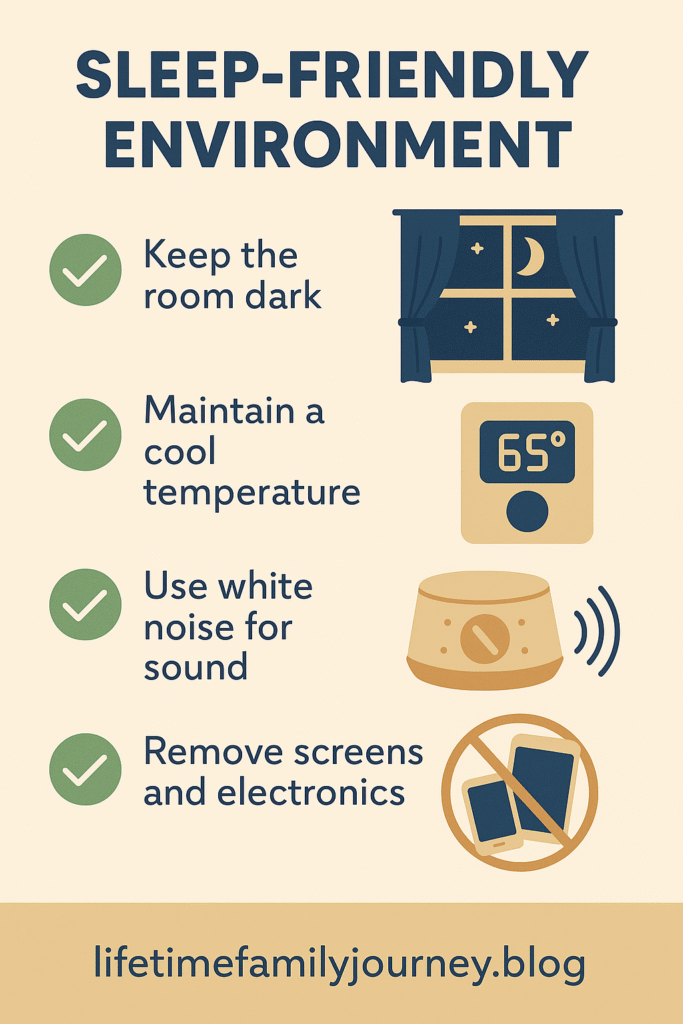
Different family members need different sleep environments, and that’s perfectly okay. Toddlers might need complete darkness and white noise, while teenagers might sleep better with slightly different conditions. Younger children often benefit from comfort objects—special blankets, stuffed animals, or even pieces of clothing that smell like mom or dad.
Have you noticed how your family sleeps better in certain environments? Maybe everyone rests more soundly when it’s raining, or perhaps there are specific room arrangements that seem to promote better sleep. These observations can guide you in creating more intentional sleep environments.
For specific ideas about creating sleep-friendly spaces for children, check out our guide on DIY Kids Room Ideas That Actually Work, which includes practical tips for organizing bedrooms that promote rest and relaxation rather than chaos and overstimulation—essential components of healthy sleep habits for families.
Dealing with Sleep Disruptions (The Real-Life Stuff) 🚨
Let’s be honest: some sleep challenges go beyond establishing routines and creating perfect environments. There are nights when you’ve done everything right—consistent bedtime, calming routine, dark room, comfortable temperature—and sleep still doesn’t happen. These situations make parents question their sanity and wonder if they’re fundamentally failing.
Common Sleep Disruptions (And What Actually Helps):
Night Terrors 😱
• Child appears awake but doesn’t respond to comfort
• Usually occur during deep sleep phases
• Best response: Ensure safety, don’t try to wake them
• Most resolve within minutes and kids don’t remember them
Bedwetting 💧
• Waterproof mattress covers are your friend
• Limit fluids before bedtime, regular bathroom trips
• Key insight: Shame makes it worse, patience helps
• Most children outgrow this naturally
Sleepwalking 🚶♀️
• Gently guide back to bed without waking
• Safety first: lock doors, clear hallways
• Consider door alarms for safety alerts
What sleep disruptions does your family face? Do you have experience with any of these challenges, or are there other issues that regularly interrupt your household’s rest? Remember that most sleep problems are phases rather than permanent conditions, and seeking help when needed isn’t a sign of failure.
Sleep challenges often intersect with other family stressors. Major life transitions, new babies, moves, school changes, or family conflicts can all disrupt established patterns. During these times, flexibility and extra patience become essential. The goal isn’t perfect sleep but adequate rest while maintaining relationships through difficult periods.
When to Seek Professional Help:
• Sleep apnea signs → Snoring, restless sleep, mouth breathing, breathing pauses
• Persistent insomnia → Not improving with good sleep hygiene after several weeks
• Extreme disruptions → Sleep problems significantly impacting daily functioning
↗️ Remember: Most sleep problems are phases, not permanent conditions!
The Family Wellness Connection 💪
Quality sleep isn’t just about individual rest—it’s about family wellness and the complex ways everyone’s sleep patterns affect household dynamics, relationships, and daily functioning. When parents are well-rested, they have more patience for inevitable spills, arguments, and minor catastrophes that define family life. When children get adequate sleep, they’re better able to regulate emotions, focus on learning, and navigate social relationships successfully.
Think about your family’s worst days—the ones where everything felt hard, everyone was irritable, and minor problems escalated into major conflicts. Chances are those difficult days followed nights of poor sleep for multiple family members. Conversely, when everyone is well-rested, the same challenges that might trigger arguments on tired days often get resolved with humor, creativity, or simple patience.
📈 Sleep Quality vs. Family Harmony Chart:
FAMILY SLEEP QUALITY → DAILY OUTCOMES
😴 Poor Sleep Night:
• 6 AM: Grumpy wake-ups → Arguments over breakfast
• 8 AM: Forgotten homework → Morning stress spiral
• 3 PM: Overtired meltdowns → Sibling conflicts increase
• 6 PM: Cranky dinner time → Family tension peaks
• 8 PM: Bedtime battles → Cycle repeats
😊 Good Sleep Night:
• 6 AM: Easier wake-ups → Calmer morning routines
• 8 AM: Better focus → Homework actually gets done
• 3 PM: Stable moods → Siblings play cooperatively
• 6 PM: Pleasant dinners → Family connection time
• 8 PM: Smooth bedtimes → Positive cycle continues
🎯 Sleep-Mood Connection Stats:
• Kids who get adequate sleep: 40% fewer behavioral problems
• Well-rested parents: 60% less likely to yell or lose patience
• Families with consistent sleep: 3x more positive interactions daily
↗️ The math is simple: Better sleep = happier families!
Academic performance and sleep are intimately connected, but the relationship goes beyond helping kids focus during school hours. Well-rested children are better able to consolidate learning, form memories, and develop problem-solving skills. They’re also more likely to have positive relationships with teachers and peers, supporting their overall educational experience.
Even family arguments decrease when everyone gets adequate sleep. Sleep deprivation increases irritability, reduces emotional regulation, and makes it harder to see situations from others’ perspectives. The morning conflict over breakfast choices becomes less likely when everyone has had restorative rest.
Creating whole-family commitment to healthy sleep habits for families requires modeling desired behavior. Children learn more from observations than instructions, so parents who prioritize their own sleep and speak positively about rest are more likely to raise children who value sleep.
The ripple effects of healthy sleep habits for families extend beyond your household. Well-rested families are more likely to be engaged community members, maintain friendships, and contribute positively to schools and neighborhoods. Just like the approach we discuss in Teaching Kids Resilience: 15 Simple Ways That Work, prioritizing rest creates positive effects that extend far beyond bedtime.

Building healthy sleep habits for families might require temporary sacrifices or adjustments to social schedules, work commitments, or activity participation. But families who prioritize rest often find they have more energy and enthusiasm for activities and relationships that matter most.
How has your family’s sleep quality affected other areas of your life? Have you noticed connections between rest and mood, academic performance, or family harmony? These observations can motivate continued commitment to healthy sleep habits for families even when establishing new practices feels challenging.
Making It Sustainable (Because Perfect Doesn’t Exist) ✨
After years of navigating family sleep challenges with six children—from colicky babies to teenage night owls—I’ve learned that sleep isn’t a luxury we enjoy when everything else is perfect. It’s survival fuel that enables us to handle everything else life throws at us.
Perfect sleep habits don’t exist, despite what social media might suggest. Real families deal with sick children, work deadlines, travel schedules, and occasional midnight emergencies that disrupt even the best-established routines. The goal isn’t perfection but progress—creating systems that support good sleep most of the time while maintaining flexibility for life’s inevitable disruptions.
Reality Check: What “Good Enough” Sleep Looks Like
• Most nights follow your routine (not every single night)
• Flexibility during illness, travel, or family emergencies
• Progress over perfection → Small improvements count
• Individual differences → What works for one child might not work for another
• Seasonal adjustments → School schedules vs. summer schedules
↗️ Key insight: Sustainable beats perfect every time!
📊 Realistic Sleep Success Metrics:
PERFECTIONIST GOALS | REALISTIC FAMILY GOALS
✗ 100% routine compliance | ✓ 80% routine consistency
✗ Same bedtime every night | ✓ Within 30-min window most nights
✗ Zero sleep disruptions | ✓ Handle disruptions calmly
✗ All kids sleep 12+ hours | ✓ Each child gets their needed amount
✗ Parents never tired | ✓ Parents get 7+ hours most nights
🎯 Monthly Sleep Goal Tracker:
• Week 1: Establish consistent bedtime routine → Target: 5/7 nights
• Week 2: Add wind-down hour → Target: 4/7 nights
• Week 3: Optimize sleep environment → Target: 6/7 nights
• Week 4: Fine-tune individual needs → Target: 5/7 nights
↗️ Celebrate small wins: Even 2-3 good sleep nights per week is progress worth celebrating!
Some nights, bedtime routines will fall apart. Someone will have a nightmare, a teenager will have a crisis needing immediate attention, or you’ll find yourself dealing with a stomach bug requiring middle-of-the-night laundry changes. These experiences don’t represent failure—they represent real family life. The key is returning to healthy sleep habits for families as soon as possible rather than using difficult nights as excuses to abandon beneficial routines entirely.
The investment you make in establishing healthy sleep habits for families pays dividends for years. Children who learn to value sleep and develop good sleep hygiene carry these skills into adulthood. Parents who prioritize their own rest model self-care and create emotional and physical resources needed for long-term parenting success.
Creating sustainable healthy sleep habits for families requires acknowledging your family’s unique needs, schedules, and personalities rather than trying to implement someone else’s perfect system. The bedtime routine that works for your neighbor’s family might be completely wrong for yours, and that’s okay. Effective rest practices are custom solutions, not one-size-fits-all approaches.

What aspects of sleep management feel most challenging for your family right now? Are there specific areas where you feel like you’re constantly struggling, or have you found some strategies that work well? Understanding your unique challenges helps create more targeted approaches to improving rest and developing healthy sleep habits for families.
Remember that establishing healthy sleep habits for families is an ongoing process rather than a destination. Family needs change as children grow, life circumstances shift, and new challenges emerge. The bedtime routine that worked perfectly for your three-year-old might need significant modifications when they turn seven.
For more insights on adapting family systems as your household evolves, check out our guide on Parenting Survival Tips.
Sweet Dreams Are Made of This 🌙
Creating healthy sleep habits for families isn’t about achieving Pinterest-perfect bedrooms or implementing complex systems requiring military precision. It’s about recognizing that sleep is foundational to family wellness and making intentional choices that support rest for everyone in your household.
The most successful approaches are simple, consistent, and tailored to your specific family’s needs and circumstances. They acknowledge the science of sleep while remaining practical for real-life implementation. They prioritize progress over perfection and flexibility over rigidity.
As you work toward better rest, remember that small changes often create significant results over time. Dimming lights an hour earlier, establishing consistent bedtimes, or creating phone-free bedrooms might seem like minor adjustments, but their cumulative effect on family wellness can be transformative.
🏆 The Sleep Habit Transformation Timeline:
WEEK 1-2: Foundation Building
→ Establish consistent bedtime routine
→ Dim lights 1 hour before bed
→ Remove screens from bedrooms
Expected result: 20% better sleep quality
WEEK 3-4: Environment Optimization
→ Adjust room temperature (65-68°F)
→ Add white noise or earplugs
→ Invest in blackout curtains
Expected result: 40% improvement in sleep duration
WEEK 5-8: Individual Fine-Tuning
→ Customize routines per child's needs
→ Address specific sleep challenges
→ Create family sleep rules together
Expected result: 60% overall family sleep satisfaction
WEEK 9-12: Mastery & Maintenance
→ Handle disruptions calmly
→ Adjust for seasons/schedule changes
→ Celebrate sleep wins regularly
Expected result: 80% consistent healthy sleep habits
📈 Progress Tracking Arrows:
• Sleep Quality: Poor → Fair → Good → Excellent
• Morning Moods: Grumpy → Neutral → Pleasant → Cheerful
• Bedtime Battles: Daily → Weekly → Occasional → Rare
• Family Harmony: Tense → Stable → Connected → Joyful
↗️ Remember: Every small step forward counts, even if progress feels slow!
Your family’s sleep journey will be unique, with its own challenges, victories, and occasional setbacks. Embrace the process, celebrate improvements, and remember that every night offers a fresh opportunity to create the restful, restorative sleep your family deserves.
If a family of eight can figure out healthy sleep habits for families most nights—complete with varying schedules, different developmental stages, and the occasional bout of midnight creativity from someone who decides 2 AM is perfect for rearranging bedroom furniture—yours can too. It takes patience, consistency, and willingness to adjust strategies when something isn’t working, but the payoff in family wellness and daily functioning makes the effort worthwhile.
The choice between rest and chaos isn’t always obvious in the moment. Staying up late to finish household tasks might seem productive, but it often leads to less patience and energy the next day. Allowing children to skip bedtime routines might avoid immediate conflicts but can create bigger sleep problems over time.
⚖️ Sleep Decision Matrix:
SHORT-TERM THINKING | LONG-TERM HEALTHY SLEEP HABITS
"Just one more episode..." | → Set viewing cutoff times
"Kids can stay up tonight" | → Maintain consistent bedtimes
"I'll do laundry after 11" | → Morning tasks = better sleep
"Homework before bed is OK" | → Afternoon homework schedule
"Weekend = no rules" | → Flexible but consistent
🔄 The Sleep-Success Feedback Loop:
• Better Sleep ➤ More Energy ➤ Better Choices ➤ Less Stress ➤ Better Sleep
• Poor Sleep ➤ Low Energy ➤ Poor Choices ➤ More Stress ➤ Worse Sleep
🎯 Daily Sleep Investment Return:
• Invest 30 minutes in bedtime routine → Get 2+ hours of family peace the next day
• Invest in consistent wake times → Get easier mornings all week
• Invest in sleep environment → Get months of better rest
• Invest in family sleep rules → Get years of healthy habits
↗️ Bottom line: Every minute spent on healthy sleep habits pays dividends in family happiness!
Now I’d love to hear from you! What’s your most memorable bedtime story—the funny, challenging, or downright bizarre sleep situation that perfectly captures life in your household? 😂 Share in the comments below! Whether it’s the night your toddler decided to redecorate their room with diaper cream at 3 AM, the time your teenager sleepwalked to the kitchen and made a sandwich, or the evening your carefully planned routine was derailed by a sudden obsession with counting ceiling tiles, your experiences help other parents feel less alone in this journey toward healthy sleep habits for families.
Sweet dreams, and remember—healthy sleep habits for families are absolutely achievable, even when it feels impossible some nights! 💤
More from Our Family of Blogs:
Lifetime Family Journey – Stories, guides, and lessons from life in a big family.
Mountains Will Move – Faith, resilience, and encouragement for life’s hardest battles.
Everyday Exposed – Real talk on culture, media, and the world we’re raising our kids in.
